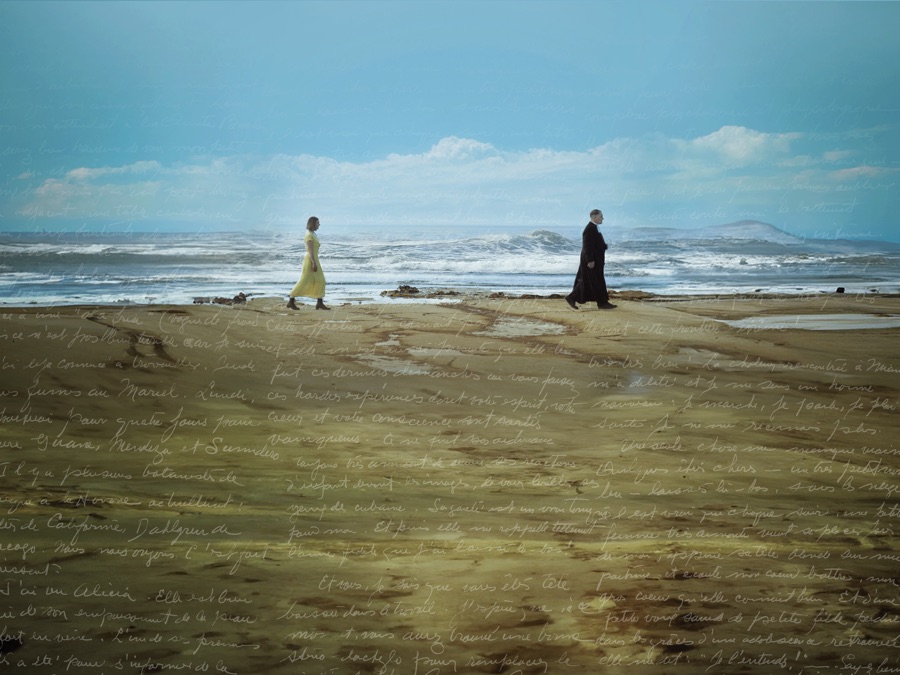by Hudson Moura
At its core, Tell Me Why These Things Are So Beautiful (Dis-moi pourquoi les choses sont si belles) is a complex meditation on the intersection of desire, science, and faith. The film plays with time and narrative, drawing viewers into a layered exploration of relationships through both a historical and a present-day lens. The film opens with a “trompe-l’œil narratif,” a narrative misdirection that immediately sets the tone: the camera follows the limping footsteps of a woman in old-fashioned shoes, leading us to believe we are in the past. However, the shot soon reveals a group of actors reading a dramatic text in the present day, preparing to film a story about nature, beauty, and divine connection.
The central narrative revolves around Marcelle, a young woman in the 1940s who becomes fascinated with botany and the natural world after meeting Brother Marie-Victorin (born Conrad Kirouac), a renowned botanist and founder of Montreal’s Botanical Garden. Their mutual passion for nature and photography blossoms into a more profound, if forbidden, connection. The film intertwines this historical relationship with the developing bond between the actors portraying them—Roxanne and Antoine—adding a layer of complexity to the narrative. As the film progresses, it becomes clear that the attraction between Conrad and Marcelle mirrors the connection between Roxanne and Antoine.

While Marcelle’s mother is more concerned with women’s suffrage, Marcelle immerses herself in the natural world, seeing it as a path toward the divine. Her studies with Brother Marie-Victorin go beyond botany; he gifts her a camera, symbolizing their shared interest and perhaps something more. The film often juxtaposes their growing intellectual bond with discussions on chastity and sexuality, which adds tension to their relationship. This dialogue, particularly explicit for the 1940s, delves into the biology of sexual organs and the religious perspective on chastity, highlighting the distance between their desires and the societal restrictions of their time.
The film is based on the real-life epistolary exchange between Brother Marie-Victorin and Marcelle Gavreau, his student. These letters, filled with scientific musings and deep emotional confessions, are the story’s backbone, representing an advanced dialogue on botany and sexuality for their time. However, while initially intriguing, the film’s decision to weave in the actors’ modern-day affair between Antoine and Roxanne becomes less convincing as the story progresses. This subplot feels underdeveloped and detracts from the richer, more nuanced relationship between Conrad and Marcelle. The affair between Antoine and Roxanne doesn’t deepen the primary narrative; instead, it is an unnecessary distraction.
The dialogue between Conrad and Marcelle is, in contrast, incredibly advanced for their time, blurring the lines between scientific curiosity and forbidden desire. Their discussions on sexuality, infused with a deeply intellectual and religious context, reveal a powerful bond that remains unconsummated as both maintain their innocence—Marcelle for Conrad and Conrad for God. Yet, the decision to depict the actors’ sexual relationship as a symbolic stand-in for the unfulfilled desires of Brother Marie-Victorin and Marcelle feels reductive. It simplifies the complexity of the historical relationship and, in some ways, undermines the film’s otherwise intricate portrayal of love and restraint. The decision to focus on this modern-day affair rather than the historically significant relationship between Conrad and Marcelle feels somewhat anticlimactic, especially given the film’s final credits, which highlight the real-life impact of these two historical figures on Quebec’s cultural and scientific legacy.
While Tell Me Why These Things Are So Beautiful offers a thoughtful examination of the intersection between faith, science, and desire, it occasionally stumbles in its execution. The modern-day subplot distracts from the richer historical narrative, and the final resolution leaves viewers questioning whether the parallel storylines were necessary to convey the film’s themes. Nevertheless, the film reclaims the tradition of beautiful pastoral imagery often seen in Quebecois cinema, while offering an intriguing exploration of intellectual and emotional connections. It delves into a historical relationship that defied the societal norms of its time, blending the beauty of nature with a complex, thought-provoking narrative. The beauty of the film lies not in its resolution but in the questions it raises about the nature of love, desire, and the boundaries we place on ourselves.
The film will be presented at Cinéfranco—Festival International du film francophone, from November 1 to 10, 2024.